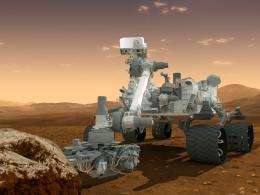This artist's concept features NASA's Mars Science Laboratory Curiosity rover, a mobile robot for investigating Mars' past or present ability to sustain microbial life. Image credit: NASA/JPL-Caltech
As NASA's Mars Science Laboratory (MSL) celebrates four years on the Red Planet Leicester planetary scientist Professor John Bridges recounts the mission's success and explains what is next for the one-ton nuclear-powered science robot.
The Curiosity rover hit the dusty surface of Mars on 6 August 2012 - and began its mission of finding evidence about whether ancient Mars offered environmental conditions conducive for microbial life.
In March 2013 NASA reported that it had achieved its primary objective after scientists found evidence of oxygen, nitrogen, hydrogen, sulphur, phosphorous and carbon – all essential for supporting living organisms.
Now, the mission, which was scheduled to end this year, has recently been given a two-year extension, with the University of Leicester's Professor John Bridges continuing as part of the extended NASA science team.
He said: "It's been a great four years – from the excitement of landing we have now had 1421 Martian days of operations and driven 13.6 km.
"We have learnt an enormous amount about Mars.
"The old idea of Mars as a simple basaltic planet that experienced a few catastrophic floods has been disproved.
"We have encountered ancient lakes and a silica rich crust.
"Our laser – ChemCam – has made over 350,000 shots on Mars and we are busily interpreting the data.
"Our plutonium power source can keep us going for years to come.
"For the next few years we will gradually climb further up Mount Sharp, at the moment we are in foothills called Murray Buttes."
As part of the fourth year celebration NASA has released a smartphone game, which lets users control their own MSL across the rugged terrain of Mars searching for water.
The app is aimed at increasing the popularity of science, said Michelle Viotti, manager of Mars public engagement initiatives at NASA's Jet Propulsion Laboratory, in Pasadena, California.
She said: "The interest that is shared through gameplay also helps us open a door to deeper literacy in science, technology, engineering and mathematics."
Curiosity landed inside Mars' Gale Crater on 6 August 2012, with a touchdown technique called the sky-crane manoeuvre.
During the rover's first Earth year on Mars, the mission accomplished its main goal when it found and examined an ancient habitable environment.
Researchers determined that a freshwater lake at the Yellowknife Bay site billions of years ago offered the chemical ingredients and energy favourable for supporting microbial life, if life has ever existed on Mars.
Provided by University of Leicester
























